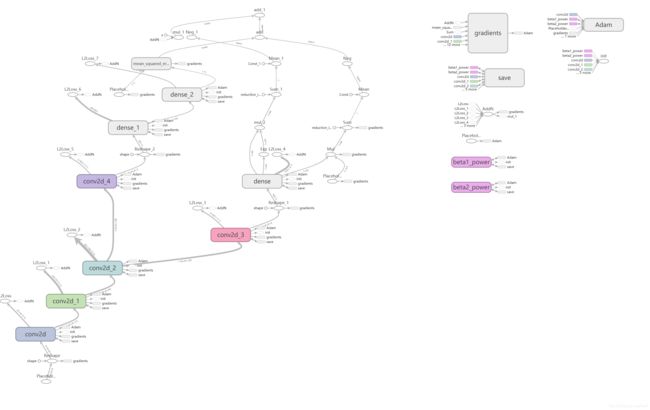import numpy as np
import tensorflow as tf
from game import Board, Game
from policy_value_net_tensorflow import PolicyValueNet # Tensorflow
n = 5
width, height = 8, 8
model_file = 'current_policy.model'
board = Board(width=width, height=height, n_in_row=n)
game = Game(board)
board.init_board(0)
input_states = tf.placeholder(
tf.float32, shape=[None, 4, height, width])
input_states_reshaped = tf.reshape(
input_states, [-1, height, width, 4])
# 2. Common Networks Layers
conv1 = tf.layers.conv2d(inputs=input_states_reshaped,
filters=32, kernel_size=[3, 3],
padding="same", activation=tf.nn.relu)
conv2 = tf.layers.conv2d(inputs=conv1, filters=64,
kernel_size=[3, 3], padding="same",
activation=tf.nn.relu)
conv3 = tf.layers.conv2d(inputs=conv2, filters=128,
kernel_size=[3, 3], padding="same",
activation=tf.nn.relu)
# 3-1 Action Networks
action_conv = tf.layers.conv2d(inputs=conv3, filters=4,
kernel_size=[1, 1], padding="same",
activation=tf.nn.relu)
# Flatten the tensor
action_conv_flat = tf.reshape(
action_conv, [-1, 4 * height * width])
# 3-2 Full connected layer, the output is the log probability of moves
# on each slot on the board
action_fc = tf.layers.dense(inputs=action_conv_flat,
units=height * width,
activation=tf.nn.log_softmax)
# 4 Evaluation Networks
evaluation_conv = tf.layers.conv2d(inputs=conv3, filters=2,
kernel_size=[1, 1],
padding="same",
activation=tf.nn.relu)
evaluation_conv_flat = tf.reshape(
evaluation_conv, [-1, 2 * height * width])
evaluation_fc1 = tf.layers.dense(inputs=evaluation_conv_flat,
units=64, activation=tf.nn.relu)
# output the score of evaluation on current state
evaluation_fc2 = tf.layers.dense(inputs=evaluation_fc1,
units=1, activation=tf.nn.tanh)
# Define the Loss function
# 1. Label: the array containing if the game wins or not for each state
labels = tf.placeholder(tf.float32, shape=[None, 1])
# 2. Predictions: the array containing the evaluation score of each state
# which is evaluation_fc2
# 3-1. Value Loss function
value_loss = tf.losses.mean_squared_error(labels,
evaluation_fc2)
# 3-2. Policy Loss function
mcts_probs = tf.placeholder(
tf.float32, shape=[None, height * width])
policy_loss = tf.negative(tf.reduce_mean(
tf.reduce_sum(tf.multiply(mcts_probs, action_fc), 1)))
# 3-3. L2 penalty (regularization)
l2_penalty_beta = 1e-4
vars = tf.trainable_variables()
l2_penalty = l2_penalty_beta * tf.add_n(
[tf.nn.l2_loss(v) for v in vars if 'bias' not in v.name.lower()])
# 3-4 Add up to be the Loss function
loss = value_loss + policy_loss + l2_penalty
# Define the optimizer we use for training
learning_rate = tf.placeholder(tf.float32)
optimizer = tf.train.AdamOptimizer(
learning_rate=learning_rate).minimize(loss)
config = tf.ConfigProto()
config.gpu_options.allow_growth = True
# Make a session
session = tf.Session(config=config)
# calc policy entropy, for monitoring only
entropy = tf.negative(tf.reduce_mean(
tf.reduce_sum(tf.exp(action_fc) * action_fc, 1)))
# Initialize variables
init = tf.global_variables_initializer()
session.run(init)
# For saving and restoring
saver = tf.train.Saver()
# log_act_probs, value = session.run(
# [action_fc, evaluation_fc2],
# feed_dict={input_states: np.ascontiguousarray(board.current_state().reshape(-1, 4, 8,8))}
# )
# print(log_act_probs)
saver.restore(session, model_file)
state_batch=np.ascontiguousarray(board.current_state().reshape(-1, 4, width, height ))
log_act_probs, value = session.run(
[action_fc, evaluation_fc2],
feed_dict={input_states: state_batch}
)
act_probs = np.exp(log_act_probs)
print(act_probs)
winner_batch = np.reshape([1], (-1, 1))
loss, entropy, _ = session.run(
[loss, entropy, optimizer],
feed_dict={input_states: state_batch,
mcts_probs: act_probs,
labels: winner_batch,
learning_rate: 2e-3})
print(loss,entropy)
# saver.save(session, model_path_my)
log_act_probs, value = session.run(
[action_fc, evaluation_fc2],
feed_dict={input_states: state_batch}
)
act_probs = np.exp(log_act_probs)
print(act_probs)
# tf.summary.FileWriter("./logs", session.graph)

